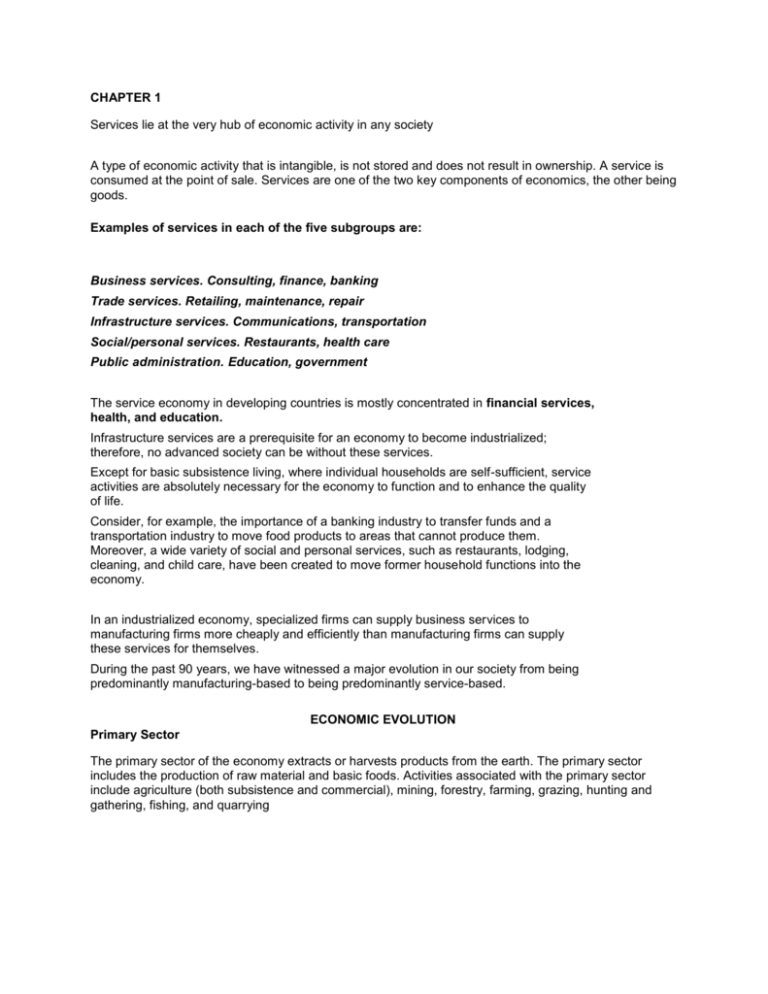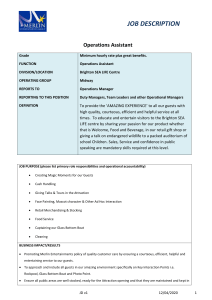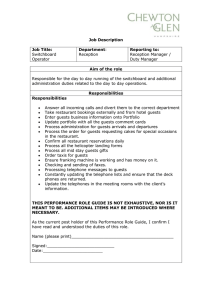chapter 1 The Role and Nature of Services in an
advertisement

CHAPTER 1 Services lie at the very hub of economic activity in any society A type of economic activity that is intangible, is not stored and does not result in ownership. A service is consumed at the point of sale. Services are one of the two key components of economics, the other being goods. Examples of services in each of the five subgroups are: Business services. Consulting, finance, banking Trade services. Retailing, maintenance, repair Infrastructure services. Communications, transportation Social/personal services. Restaurants, health care Public administration. Education, government The service economy in developing countries is mostly concentrated in financial services, health, and education. Infrastructure services are a prerequisite for an economy to become industrialized; therefore, no advanced society can be without these services. Except for basic subsistence living, where individual households are self-sufficient, service activities are absolutely necessary for the economy to function and to enhance the quality of life. Consider, for example, the importance of a banking industry to transfer funds and a transportation industry to move food products to areas that cannot produce them. Moreover, a wide variety of social and personal services, such as restaurants, lodging, cleaning, and child care, have been created to move former household functions into the economy. In an industrialized economy, specialized firms can supply business services to manufacturing firms more cheaply and efficiently than manufacturing firms can supply these services for themselves. During the past 90 years, we have witnessed a major evolution in our society from being predominantly manufacturing-based to being predominantly service-based. ECONOMIC EVOLUTION Primary Sector The primary sector of the economy extracts or harvests products from the earth. The primary sector includes the production of raw material and basic foods. Activities associated with the primary sector include agriculture (both subsistence and commercial), mining, forestry, farming, grazing, hunting and gathering, fishing, and quarrying Secondary Sector The secondary sector of the economy manufactures finished goods. All of manufacturing, processing, and construction lies within the secondary sector. Activities associated with the secondary sector include metal working and smelting, automobile production, textile production, chemical and engineering industries, aerospace manufacturing, energy utilities, engineering, breweries and bottlers, construction, and shipbuilding. Tertiary Sector The tertiary sector of the economy is the service industry. This sector provides services to the general population and to businesses. Activities associated with this sector include retail and wholesale sales, transportation and distribution, entertainment (movies, television, radio, music, theater, etc.), restaurants, clerical services, media, tourism, insurance, banking, healthcare, and law. Quaternary Sector The quaternary sector of the economy consists of intellectual activities.. That is research, development, and information. The quaternary sector can be seen as the sector in which companies invest in order to ensure further expansion. Quinary sector This sector would include the top executives or officials in such fields as government, science, universities, nonprofit, healthcare, culture, and the media. Stages of Economic Development Preindustrial Society Life is characterized as a game against nature. Working with muscle power and tradition, the labor force is engaged in agriculture,, mining, and fishing. Life is conditioned by the elements, such as the weather, the quality of the soil, and the availability of water. Productivity is low and bears little evidence of technology Industrial Society Division of labor is the operational "law" that creates routine tasks and the notion of the semiskilled worker. Work is accomplished in the artificial environment, a world of cities, factories, and tenements. The rhythm of life is machine-paced and dominated by rigid working hours and time clocks. An industrial society is a world of schedules and acute awareness of the value of time. The standard of living becomes measured by the quantity of goods, but note that the complexity of coordinating the production and distribution of goods results in the creation of large bureaucratic and hierarchic organizations. Postindustrial Society While an industrial society defines the standard of living by the quantity of goods, the postindustrial society is concerned with the quality of life, as measured by services such as health, education, and recreation. Society becomes aware that the independent actions of individuals can combine to create havoc for everyone, as seen in traffic congestion and environmental pollution. The community rather than the individual becomes the social unit. How does this happen? First, there is a natural development of services, such as transportation and utilities, to support industrial development. As labor-saving devices are introduced into the production process, more workers engage in nonmanufacturing activities, such as maintenance and repair. Second, growth of the population and mass consumption of goods increase wholesale and retail trade, along with banking, real estate, and insurance. Third, as income increases, the proportion spent on the necessities of food and home decreases, and the remainder creates a demand for durables and then for services. Ernst Engel, a Prussian statistician of the nineteenth century, observed that as family incomes increase, the percentage spent on food and durables drops while consumption of services that reflect a desire for a more enriched life increases correspondingly. This phenomenon is analogous to the Maslow hierarchy of needs, which says that once the basic requirements of food and shelter are satisfied, people seek physical goods and, finally, personal development. Higher education becomes the condition for entry into a postindustrial society –professional and technical skills. EXPLAIN THE DIFFERENCES BETWEEN THE SERVICES AND MANUFACTURING Today, service industries are the source of economic leadership The growth of the service sector has produced a less cyclic national economy, and the demand for services keeps increasing even during the negative growth trend of the economy. 1) First, by their nature, services cannot be inventoried, as is the case for products. Because consumption and production occur simultaneously for services, the demand for them is more stable than that for manufactured goods. Services are generally performed with an open-systems perspective, that is, the system is not closed or isolated from the consumer as it is in manufacturing. 2) There is a high degree of customer contact throughout the service process, with the customer frequently participating in the process itself. Customer participation within the process means that there is simultaneous production and consumption; thus, the service cannot be stored for later use, possibly as a buffer to absorb fluctuations in demand. Because consumption and production occur simultaneously for services, the demand for them is more stable than that for manufactured goods 3) Services are generally regarded as intangible, that is, you can't see, feel, or test a service's performance before purchasing it. Hence, reputation is extremely important. Since services are intangible, it makes sense that they can't be patented 4) The intangibility of services sometimes makes it difficult for the service firm to identify their product. Is the product at a restaurant the food itself, the service, or the atmosphere? 5) Unlike product, services are time perishable. An empty seat on an airline means that that seat on that flight will never be available again. The usefulness of service capacity is time-dependent—another reason that services cannot be inventoried and held for a later date 6) Services can also have very weak barriers to entry 7) When the economy falters, many services continue to survive, hospitals, education. THE NEW EXPERIENCE ECONOMY In the 21stcentury, we consume and shop •in new ways •in different patterns And we expect many of products and services we buy •not only to fulfil a function… •but also to provide us with an experience The term Experience Economy was first described in an article published in 1998 by B. Joseph Pine II and James H. Gilmore, titled "The Experience Economy". In it they described the experience economy as the next economy following the agrarian economy, the industrial economy, and the most recent service economy. The agriculture based economy dealt mostly in raw materials: wheat to bake ones own bread, wool to knit the family garments. During the industrial revolution, millions of people moved from countryside to town, from field to factory floor. Free time was short and so not only did the factories produce steel and iron, engines and ships, they also produced tinned food and knitted clothes and the corner bakery produced the daily bread. The era of mass manufactured goods had arrived. Further economic prosperity and increased automation has increased wages and decreased the hours worked. But rather than use the increased non working time to return to making our own bread and knitting our own clothes, we (in the advanced industrial economies) have chosen to spend our time purchasing services. Restaurants now cook and serve our meal and clear the dishes; personal shoppers advise on suitable fashion garments and then they spend time making the purchase. Thus Pizza Hut offers more than a meal; it will host your child's birthday party, complete with a candle lit cake and amusements. Walt Disney with their Disney Parks is the recognised expert in offering experiences. The workers are called actors, you the visitor are the guests and the theme park becomes the stage. The four realms of Experiences1 Experiences come in different phenomena; you can lose yourself, learn things, feel it or see it. Pine & Gilmore have called these the four realms of Experience. The four realms of experiences differentiate from each other on two levels: Passive and active participation; guests either influence or don’t influence the course and result of the experience. Absorption and immersion; how guests stand in the experience. Absorption occupies a person’s attention; the experience goes into his mind. Immersing guests become physically or virtually a part of the experience, they go into the experience, movie Entertainment is a passive realm, like watching a movie; guests do nothing but respond by laughing, enjoying etc. The guests are here to stay. The educational realm requires full participation of the guest. To truly inform a guest and increase his knowledge and/or skills, this realm must actively engage the mind (for intellectual education) and/or the body (for physical training). These guests are here to learn. In the esthetic realm guests immerse themselves in an event or environment, sensing their surroundings, without influencing the happening. An atmosphere is created for guests to be.For most customers at Starbucks, they enter a “third place” sipping exotic coffee such as macchiato in the café as they are immersed in the aroma of roasted coffee while remaining passive in not influencing the environment. Escapist is like educational: active, but immersed. The guests are totally in the experience and have an active roll in it. They want to do. Imagine sitting in one of the roller-coaster rides in a Disney theme park where you are both immersed in the environment and participating in the electrifying intensity and excitement of the ride.





